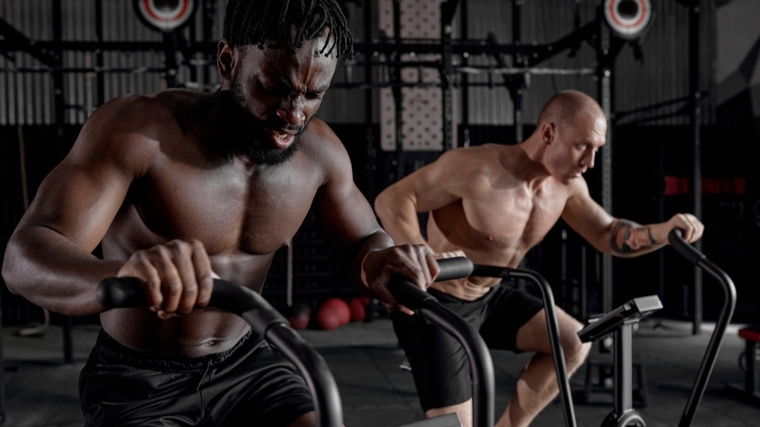You love nothing more than the sweet sound of iron clanking together in the gym. In your quest to become ever more powerful, you’ve become all about sets of heavy triples and the occasional accessory lift. But when your program calls for sets of eight and you’re too winded to continue past six, it might be time to consider some endurance training.
Even though you might want to up your stamina, you’ve got that nagging voice in your head telling you that endurance training will eat away at your muscles and ruin your strength gains. But somehow, that person you see on the treadmill every day is ripped and can still pull 500-plus pounds — so what is the truth?

It’s possible to be strong as heck and have the stamina to match (ever heard of Hybrid athlete Fergus Crawley?). But figuring out how to program endurance training for strength athletes is definitely an art in and of itself. Read on to learn what you’ve always wanted to know about how to get strong and build your endurance at the same time.
What is Endurance Training?
Endurance training is aimed at improving how well you can breathe and how efficiently your heart can work during extended bouts of exercise — AKA, improving your peak oxygen consumption and cardiac output. In contrast, strength training is geared toward getting stronger, more powerful, and building muscle mass.
Different Goals of Endurance Training
The benefit of endurance training is different for individual lifters. Bodybuilders might want to build their endurance enough to help them tolerate muscle-building 20-rep sets but don’t want to be able to run a 5k. A powerlifter might, however, be interested in boosting their max numbers while also training for a five or 10k to improve their heart health.

CrossFitters may need to build extreme levels of endurance at high intensities as opposed to low-intensity endurance activities like slow jogging. And some recreational lifters might want to be able to enjoy the occasional long hike while also training to improve their overhead press max.
Similarly, just starting out in training might mean building up to jogging for 10 consecutive minutes. A more experienced athlete might consider working up to jogging 10 miles to be endurance training.
What is Concurrent Training?
Concurrent training refers to training for two goals at the same time — in this context, training to improve both strength and endurance. You might be training primarily to increase strength, with some endurance thrown in. Or, you might be looking to run long distances and toss some strength training in for good measure.
Just as the definition of “endurance training” varies depending on your goals and experience levels, the parameters of concurrent training change from person-to-person. A strength athlete who’s never run before is going to have a much different approach to concurrent training than a former cross-country athlete.
Benefits of Concurrent Training for Strength Athletes
So you want to increase your endurance while primarily training for strength. But if you need some talking points for when you’re trying to convince your gym buddy that concurrent training won’t kill your gains, check these benefits out.
Increase Muscular Performance
Many people have fears about endurance training interfering with muscle growth or “shrinking” their muscles. However, research shows that well-programmed endurance training does not negatively impact muscle growth. (1)(2) In fact, especially for aging populations, concurrent training can increase both muscular performance and general functioning in daily life. (3)

Endurance exercise selection is important here. While running may sometimes interfere with strength and muscle gain, cycling doesn’t seem to make it harder to gain muscle. (4) If you’re still worried about making sure you’re building sleeve-busting arms while also endurance training, try separating your strength and endurance sessions by at least three hours. (5)
Boost Work Capacity
Work capacity is the amount of work you can do in a given amount of time. You might be able to squat 225 pounds 20 times, for example. But can you do it within a single set, or spread it out over four or five sets with big rests in between? The single-set version demonstrates a higher work capacity.
By concurrently training for both strength and endurance, you’ll increase your body’s work capacity. This will improve your ability to move heavier weights more often. With a high work capacity, you can recover faster in between sets and handle more load day-to-day and week-to-week. Even if you’re lifting heavy, increasing your training volume like that requires endurance. And that’s what concurrent training can offer you.
Emotional Satisfaction
Sure, you might have a main goal in the gym — upping your deadlift max or finally being able to crank out a clean set of 10 pull-ups. But human beings rarely have just one goal at a time. The same applies to training. If you’re just grinding away at a single goal, you might get frustrated or bored. But if you’re performing diverse training activities that you enjoy, you’re more likely to draw emotional satisfaction, confidence, and consistency from your training. (6)
Drawbacks of Concurrent Training for Strength Athletes
It’s not all roses and sunshine when you’re looking to train for strength and endurance concurrently. Sometimes, looking to get strong and run a 10k at the same time can put a damper on your goals.
Interference Effect on Strength
The “interference effect” is the idea that aerobic endurance training might cancel out the effects of strength training and inhibit your strength gains. And that idea seems to have some validity. High-volume running programs, performed concurrently with strength training, can sometimes slow an athlete’s progress at building strength — particularly in their lower body. (4)(7)
Interference Effect on Power and Explosivity
If you’re looking to improve power, avoid programming strength training before explosive high-intensity interval training (HIIT). (8)(9) Concurrent training only seems to interfere with power development when you perform your endurance and strength training back-to-back. Separating your sessions by at least three hours seems to eliminate this interference effect. (1)(9)

That said, if you’re pressed for time, be aware that you might not be able to perform as explosively as you would if you were just focusing on power training.
Will Endurance Training Hurt Your Strength Gains?
If you program your training according to your experience level and your goals, then endurance work won’t necessarily interfere with your strength training. As long as you take into account some key considerations, you may not need to worry about the interference effect.
For Beginners
If you’re enjoying sweet newbie gains, there’s no reason to avoid training for both endurance and strength. Concurrent aerobic and strength training three times a week for 12 weeks can make you stronger. You’ll also increase your work capacity and peak oxygen uptake. That is, you’ll improve how hard you can work in a single session and how easily you can breathe while doing so. (10)
But even if you’re just starting out, your main goal may well be getting strong and jacked. Don’t worry — aerobic endurance work alongside your strength training won’t interfere with your pursuit of that new one-rep max. (11)
For Intermediate Lifters
As an intermediate lifter, you have a good base in strength training. Since you haven’t necessarily specialized in a sport or lift, you might be programming a high amount of training volume. Try to prioritize that strength volume over your endurance volume. Trying to pack on maximum levels of both types of training may hurt your strength goals. (5)

However, concurrent training where the endurance training is via cycling (rather than running) does not seem to cancel out strength gains. (4) However, you’ll also want to keep in mind the demands of your sport and daily life when programming concurrent training. For example, research suggests that interference with strength gains might come from athletes’ endurance-related activities outside of training. (12) So, don’t forget to “count” those hours of housework or walking your dog toward your endurance training.
For Advanced Lifters
The more advanced you are in your lifting, the more complicated concurrent training can be — but that doesn’t mean it can’t be done. Think about CrossFit. Especially at the top levels, CrossFitters need to be able to snatch, jerk, and deadlift heavy. All the while, they need enough endurance to just not stop.
That said, the more specialized you are in your sport, the more you need to consider training specificity. You especially need to be specific around competition time (if you compete). Experienced strength athletes whose main focus is improving their sport might want to train endurance at a high intensity but a low volume and frequency. (5) Think short HIIT sessions a couple times a week. The low volume might help protect from interference effects, while the high intensity facilitates gains.
Programming Endurance Training for Strength Athletes
Strength athletes might have different goals depending on what training season and cycle they’re in. Sometimes, you’re trying to build maximum strength and other times, you’re focused on hypertrophy or power development.
Frequency
Regardless of your specific focus, prioritize your recovery as a strength athlete. Adequate recovery will help you make gains in both endurance and strength. You’ll want to avoid overloading your body with high volumes of both types of training. If your main focus is strength training with a side of endurance, try using a 2:1 or 3:1 strength:endurance training ratio. (5) This will help maximize your goals on all sides while keeping the emphasis on your strength sessions.
Exercise Order
Perform your strength and hypertrophy training before endurance work to avoid as much interference with your gains and recovery as possible. (5) If you can, separate your strength and endurance sessions by three to six hours — or as long as 24 hours if your program allows — instead of performing them back-to-back. (5)
However, if your goal is power, your power and endurance training might be occurring in the same session. That’s because HIIT is a training modality many people use to build both their power and stamina. That said, aim to perform your training priorities first in your program. In this case, you might want to perform power-based HIIT workouts before strength training. Programming strength training sessions first might decrease your power output during your HIIT session. (8)(9)
More Than One Goal
Have you been hesitating to bring endurance training into your program because you’ve been worried about it eating away your muscles? Concurrent training can help you build your strength and cardiovascular health as long as you program it carefully. So rest — or exercise — assured that paying close attention to your body and goals can help you train for the best of both worlds.
References
- Schumann, M., Feuerbacher, J.F., Sünkeler, M. et al. Compatibility of Concurrent Aerobic and Strength Training for Skeletal Muscle Size and Function: An Updated Systematic Review and Meta-Analysis. Sports Med 52, 601–612 (2022).
- Fyfe JJ, Bartlett JD, Hanson ED, Stepto NK, Bishop DJ. Endurance Training Intensity Does Not Mediate Interference to Maximal Lower-Body Strength Gain during Short-Term Concurrent Training. Front Physiol. 2016 Nov 3;7:487.
- Wilhelm EN, Rech A, Minozzo F, Botton CE, Radaelli R, Teixeira BC, Reischak-Oliveira A, Pinto RS. Concurrent strength and endurance training exercise sequence does not affect neuromuscular adaptations in older men. Exp Gerontol. 2014 Dec;60:207-14.
- Wilson JM, Marin PJ, Rhea MR, Wilson SM, Loenneke JP, Anderson JC. Concurrent training: a meta-analysis examining interference of aerobic and resistance exercises. J Strength Cond Res. 2012 Aug;26(8):2293-307.
- Methenitis S. A Brief Review on Concurrent Training: From Laboratory to the Field. Sports (Basel). 2018 Oct 24;6(4):127.
- Lakicevic, N., Gentile, A., Mehrabi, S., Cassar, S., Parker, K., Roklicer, R., Bianco, A., & Drid, P. (2020). Make Fitness Fun: Could Novelty Be the Key Determinant for Physical Activity Adherence?. Frontiers in psychology, 11, 577522.
- Fyfe JJ, Bartlett JD, Hanson ED, Stepto NK, Bishop DJ. Endurance Training Intensity Does Not Mediate Interference to Maximal Lower-Body Strength Gain during Short-Term Concurrent Training. Front Physiol. 2016 Nov 3;7:487.
- Lee MJ, Ballantyne JK, Chagolla J, Hopkins WG, Fyfe JJ, Phillips SM, Bishop DJ, Bartlett JD. Order of same-day concurrent training influences some indices of power development, but not strength, lean mass, or aerobic fitness in healthy, moderately-active men after 9 weeks of training. PLoS One. 2020 May 14;15(5):e0233134.
- Lee, M. J., Ballantyne, J. K., Chagolla, J., Hopkins, W. G., Fyfe, J. J., Phillips, S. M., Bishop, D. J., & Bartlett, J. D. (2020). Order of same-day concurrent training influences some indices of power development, but not strength, lean mass, or aerobic fitness in healthy, moderately-active men after 9 weeks of training. PloS one, 15(5), e0233134.
- Bassi, D., Mendes, R.G., Arakelian, V.M. et al. Potential Effects on Cardiorespiratory and Metabolic Status After a Concurrent Strength and Endurance Training Program in Diabetes Patients — a Randomized Controlled Trial. Sports Med – Open 2, 31 (2016).
- Karavirta L, Häkkinen A, Sillanpää E, García-López D, Kauhanen A, Haapasaari A, Alen M, Pakarinen A, Kraemer WJ, Izquierdo M, Gorostiaga E, Häkkinen K. Effects of combined endurance and strength training on muscle strength, power and hypertrophy in 40-67-year-old men. Scand J Med Sci Sports. 2011 Jun;21(3):402-11.
- Hyttinen AM, Häkkinen K. Effects of strength vs. endurance training and their combination on physical performance characteristics in female horseback riders. J Sports Med Phys Fitness. 2020 Jun;60(6):814-822.
Featured Image: Roman Chazov / Shutterstock
